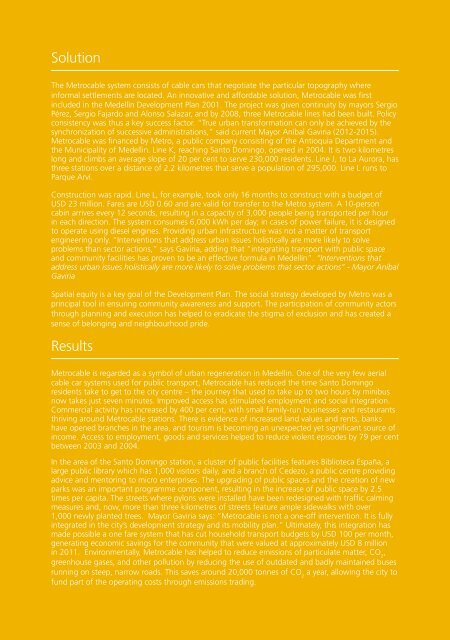Urban Planning for City Leaders - Cities Alliance
Urban Planning for City Leaders - Cities Alliance
Urban Planning for City Leaders - Cities Alliance
You also want an ePaper? Increase the reach of your titles
YUMPU automatically turns print PDFs into web optimized ePapers that Google loves.
How to make a city saferSolutionThe Metrocable system consists of cable cars that negotiate the particular topography wherein<strong>for</strong>mal settlements are located. An innovative and af<strong>for</strong>dable solution, Metrocable was firstincluded in the Medellín Development Plan 2001. The project was given continuity by mayors SergioPérez, Sergio Fajardo and Alonso Salazar, and by 2008, three Metrocable lines had been built. Policyconsistency was thus a key success factor. “True urban trans<strong>for</strong>mation can only be achieved by thesynchronization of successive administrations,” said current Mayor Aníbal Gaviria (2012-2015).Metrocable was financed by Metro, a public company consisting of the Antioquia Department andthe Municipality of Medellin. Line K, reaching Santo Domingo, opened in 2004. It is two kilometreslong and climbs an average slope of 20 per cent to serve 230,000 residents. Line J, to La Aurora, hasthree stations over a distance of 2.2 kilometres that serve a population of 295,000. Line L runs toParque Arví.Construction was rapid. Line L, <strong>for</strong> example, took only 16 months to construct with a budget ofUSD 23 million. Fares are USD 0.60 and are valid <strong>for</strong> transfer to the Metro system. A 10-personcabin arrives every 12 seconds, resulting in a capacity of 3,000 people being transported per hourin each direction. The system consumes 6,000 kWh per day; in cases of power failure, it is designedto operate using diesel engines. Providing urban infrastructure was not a matter of transportengineering only. “Interventions that address urban issues holistically are more likely to solveproblems than sector actions,” says Gaviria, adding that “integrating transport with public spaceand community facilities has proven to be an effective <strong>for</strong>mula in Medellín”. “Interventions thataddress urban issues holistically are more likely to solve problems that sector actions” - Mayor AníbalGaviriaSpatial equity is a key goal of the Development Plan. The social strategy developed by Metro was aprincipal tool in ensuring community awareness and support. The participation of community actorsthrough planning and execution has helped to eradicate the stigma of exclusion and has created asense of belonging and neighbourhood pride.ResultsMetrocable is regarded as a symbol of urban regeneration in Medellin. One of the very few aerialcable car systems used <strong>for</strong> public transport, Metrocable has reduced the time Santo Domingoresidents take to get to the city centre – the journey that used to take up to two hours by minibusnow takes just seven minutes. Improved access has stimulated employment and social integration.Commercial activity has increased by 400 per cent, with small family-run businesses and restaurantsthriving around Metrocable stations. There is evidence of increased land values and rents, bankshave opened branches in the area, and tourism is becoming an unexpected yet significant source ofincome. Access to employment, goods and services helped to reduce violent episodes by 79 per centbetween 2003 and 2004.In the area of the Santo Domingo station, a cluster of public facilities features Biblioteca España, alarge public library which has 1,000 visitors daily, and a branch of Cedezo, a public centre providingadvice and mentoring to micro enterprises. The upgrading of public spaces and the creation of newparks was an important programme component, resulting in the increase of public space by 2.5times per capita. The streets where pylons were installed have been redesigned with traffic calmingmeasures and, now, more than three kilometres of streets feature ample sidewalks with over1,000 newly planted trees. Mayor Gaviria says: “Metrocable is not a one-off intervention. It is fullyintegrated in the city’s development strategy and its mobility plan.” Ultimately, this integration hasmade possible a one fare system that has cut household transport budgets by USD 100 per month,generating economic savings <strong>for</strong> the community that were valued at approximately USD 8 millionin 2011. Environmentally, Metrocable has helped to reduce emissions of particulate matter, CO 2,greenhouse gases, and other pollution by reducing the use of outdated and badly maintained busesrunning on steep, narrow roads. This saves around 20,000 tonnes of CO 2a year, allowing the city tofund part of the operating costs through emissions trading.125
















